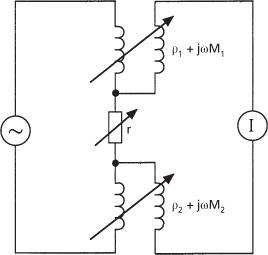An alternating-current bridge that measures mutual inductance. Direct comparison of a mutual inductance with a standard mutual inductance is virtually impossible because effects, such as the self- and mutual capacitances of the coils, produce voltage components in the secondary circuits in phase with the primary current. This problem is overcome in the Hartshorn bridge by the use of a variable resistor, of resistance r, common to both the primary and secondary circuits of the bridge (see diagram). The standard inductance and the resistance are varied until a balance is achieved with no response registered by the indicating instrument I; assuming that the secondaries are connected in antiphase, then
where ρ1 and ρ2 are the resistances of the mutual inductances M1 and M2.

Hartshorn bridge
- mixed farming
- mixed function oxidase
- mixed logic
- mixed methods research
- mixed numbers
- mixed pixel
- mixed-radix system
- mixed strategy
- mixed-valence compound
- mixed-valence compounds
- mixer
- mixer noise balance
- mixer-settler
- mixing
- mixing condensation level
- mixing depth
- mixing ratio
- mixing rule
- mix of policies
- mixolimnion
- mixotrophic
- Mixtec
- mixture
- mixture distribution
- mixture of labour